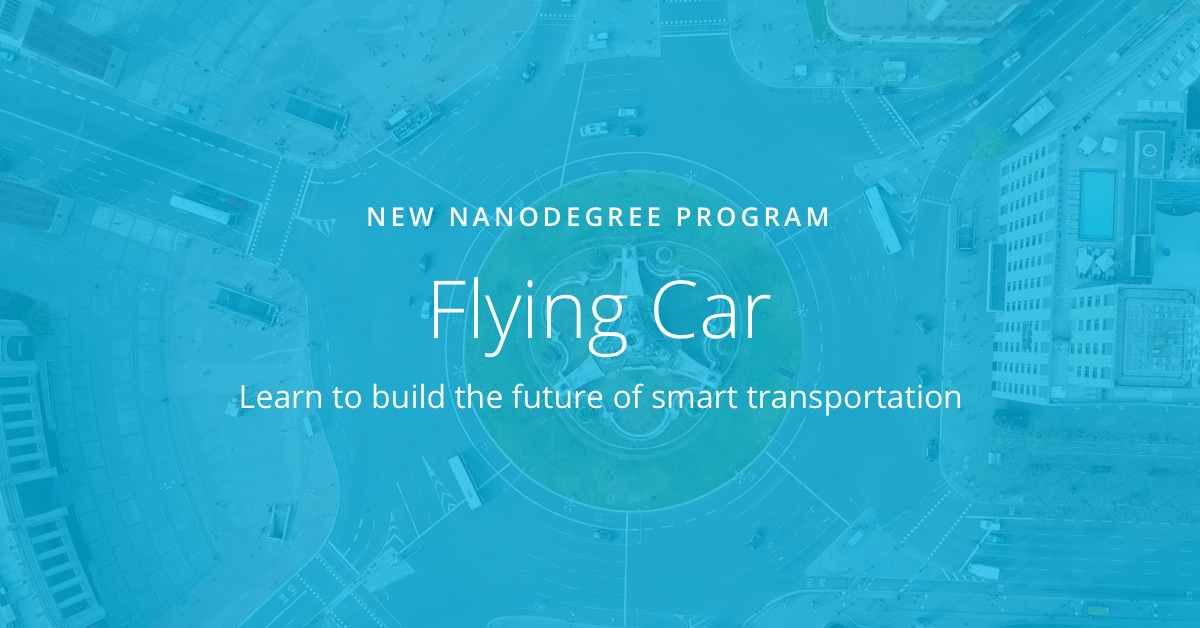Udacity Introduces the Flying Car Nanodegree Program

Transportation innovation has powered dramatic growth across industries, cultures, and geographies for centuries. From the covered wagon to self-driving cars on the ground, and from hot air balloons to drones in the sky, our world has changed as we’ve developed new ways to traverse it, and as technology progresses, the lines between ground and air begin to disappear.
Introducing the Flying Car Nanodegree program
The idea of a ‘Flying Car” is metaphor for a new vision for the future of smart transportation. In launching a Flying Car Nanodegree program, our goal is to teach a new generation of engineers the skills necessary to build this smart transportation future. We want to teach students to push beyond the current generation of quadrotors and remote-controlled drones, and give them the skills to create autonomous flight vehicles that will be crucial to the transportation systems of the future.
Our curriculum will initially focus on the basics of autonomous flight including motion planning, state estimation, control, and perception. But over the course of two terms, students will gain an understanding of the bigger picture of autonomous flight as part of the air transportation system, and especially the challenges of safe and reliable autonomous flight. They will develop skills in systems integration through hands-on projects that include both flight simulation and the option to deploy code on a small drone. Our students will develop the software skills and conceptual understanding necessary to build a flight system for an autonomous flight vehicle that can reliably complete complex missions in urban environments.
My Curriculum Partners: Sebastian Thrun, Raffaello D’Andrea, and Angela Schoellig
I am excited to be building this curriculum with Udacity, and collaborating with founder Sebastian Thrun, Raff D’Andrea (co-founder of Kiva Systems), and Angela Schoellig (professor in the University of Toronto Institute for Aerospace Studies). This is a truly unique opportunity to bridge many worlds and many specialties. Sebastian’s contributions to autonomy are of course well-known, and his latest work with Kitty Hawk offers an especially compelling integration of cutting-edge technologies. Raff for his part brings to the table a combination of technical virtuosity and artistic sensibility that is both rare and remarkable in this field. Angela’s recent applications of motion planning, control, and learning algorithms to self-driving vehicles represent exciting new advancements in performance, safety and autonomy. I am tremendously excited to work with these amazing colleagues to help students around the world engage with the deep and technical questions in the domain of safe and reliable autonomous flight.
Autonomous Flight Technology and Social Good
The potential applications of autonomous flight technology are incredible, and we’re already seeing powerful examples of this today. As recently written about in Wired, drones are helping in Houston in the aftermath of Hurricane Harvey. They’re enabling safety assessments for residents wondering when they can return home. They’re gathering data about damage to roads, bridges, and water treatment plants. They’re helping to identify flooding and drainage problems. As reported by NPR, telecom companies such as AT&T and Verizon are using drones to help repair emergency call centers and cellular sites. Fortune highlighted how Allstate and Farmers Insurance are deploying their own drones to process damage claims faster, and get payments to victims sooner. Already drones are beginning their work in Florida, leading NBC news to state that Hurricanes Show Why Drones Are the Future of Disaster Relief.
But even these vehicles need a lot of human effort to pilot them. Autonomous flight technology can make a powerful and positive difference in our world. A recent article entitled 9 Brilliant Ways Drones Can Help Tackle The World’s Biggest Problems included everything from humanitarian aid delivery and pollution control to combating poaching and illegal logging. Alison Cohan, director of the Nature Conservancy’s Maui Nui forest programs, recently made the observation that, “Drones are revolutionizing the way conservation can be conducted, and for far less than the cost of a helicopter or sending in ground teams.” This combination of efficiency and cost is making drone use appealing in countless other fields as well—from construction and agriculture to shipping and weather forecasting.
Building The Future of Smart Transportation
A comprehensive article published recently in The Economist broached the subject of “self-flying taxis,” noting that companies including Airbus, Uber, and Kitty Hawk are all working on the problem of flying cars. The Economist article specifically notes that path-planning and obstacle avoidance are especially difficult when considering “manned” drone flight—these are exactly the challenges our students will be tackling.
The Flying Car Nanodegree program will open in early 2018. Until then, myself, Sebastian, Raffaello, Angela, and the Udacity Flying Car Team will be hard at work completing the curriculum. I cannot wait to open the classroom doors to our first students!
Flying cars are a long way from reality, but the first prototypes are already in the air, and in the years to come we’ll see tremendous progress in this field, It was even recently reported that Toyota plans to debut their flying car at the 2020 Olympics! Whether they achieve this specific goal or not, it is certain that a new transportation future is being built even as we speak. This future will fuse land and sky, and leverage the best of what both manned and autonomous vehicles offer. These new vehicles will expand our reach, and make the previously impossible possible. Just as the covered wagon once did.



